The GIMICC orbiter, the only mission to scout the innermost planet of the Blake system, sent back imaging data of the scorched surface of Ahania. The radius of Ahania was determined to be 1275 km.
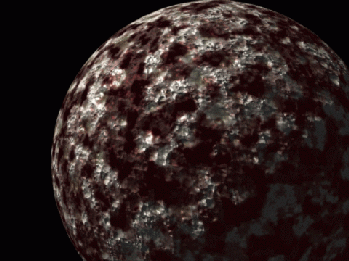
The spacecraft was inserted into an an orbit with a period of 6 hours 42 min 10 sec, with the laser range finder indicating an average altitude of 2678 km above the surface. What is the mass of Ahania?
Ahania appears to have a nearly circular orbit around Blake. Its rotational period, measured by the laser range finder on GIMICC, is 58.52 days. What sort of resonance is Ahania between its orbital period around Blake and its rotational period? What would you expect the temperatures to be like in the different hemispheres?
The most popular target for missions was the planet Tharmas, as it was expected to be well positioned in the Blake habitable zone. Many of the spacecraft carried high-resolution imagers which showed a terrestrial planet with a substantial atmosphere. Initial reports from probes gave promising indications that Tharmas is indeed capable of supporting life.
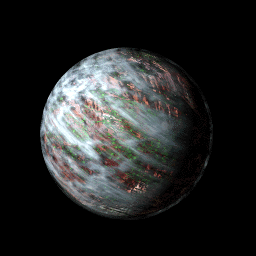
The OTIS mission snapped an image of Tharmas on its approach to the system. The angular diameter of Tharmas was determined to be 2° 35' 36" at a distance of 300,000 km. What is the physical diameter of Tharmas (in km)? Compare this to the diameter of the Earth.
The OTIS mission carried a magnetometer. It measured a magnetic field of 9.27 × 10-9 T at a distance of 150,000 km from the center of Tharmas. What is the surface magnetic field of Tharmas?
To compare magnetic fields between planets, you need to scale the (dipolar) field strengths to a common radius - such as the Earth's radius. Compare the strength of the Tharmas magnetic field with the Earth's by scaling the Tharmas field to r of one Earth radius.
Enion, the third stone from Blake, was also heavily targeted for investigation in hopes of discovering signs of life. Images show a striking surface with ice and clouds.
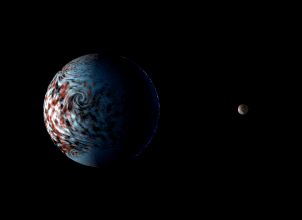
From a distance of 220,000 km, the apparent angular diameter of Enion was found to be 3° 10' 11". What is the physical diameter of Enion?
The DARTH VADER orbiter carried a Wide-Angle Imager (WAI). Examination of the images show a single satellite of Enion, named Vala, which is in a nearly circular orbit with semimajor axis of 600,000 km and period of 56 days 9 hours 50 min. What is the mass of Enion?
Given the mass and radius of Enion, it is possible to compute other important parameters. What is the mean density of Enion? What is its probable composition?
Luvah is the most mysterious of the Blake planets. It lies at the limit of the habitable zone at 4.5 AU, and might be either terrestrial or Jovian in nature. The nature of Luvah will depend upon what gases can be retained in its atmosphere, which is competition between temperature and gravity. One can derive an expression for the minimum atomic/molecular weight a for a gas to be retained on Luvah, given its mass M, radius R, and temperature T. Derive a formula for the minimum atomic/molecular weight a retained in terms of the parameters:
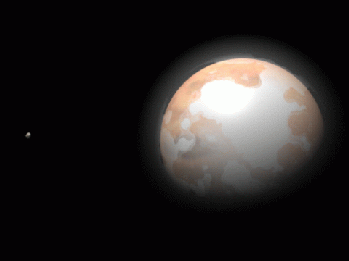
Luvah and Rahab from Livingstone I.
The Gigantic Light flyby measured an albedo of A=0.35 for Luvah. What is the expected surface temperature T for Luvah, as a function of the greenhouse factor G? What is the mean temperature at the top of the Luvah cloud deck? Which of these temperatures do we use in the above calculation for retention of gases? Explain.
Urizen is the mightiest of the giant planets orbiting Blake. It has a diameter 12.93 times that of the Earth!
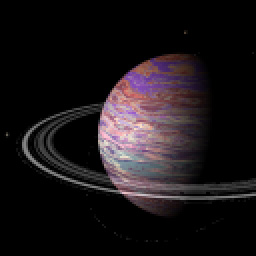
The satellite Bromion orbits Urizen with a semimajor axis of 254,000 km and a period of 15 hours 5 min. What is the mass and mean density of Urizen?
Examination of the low-resolution image obtained by the JOPRO orbiter show a double ring system, with one set of rings inclined to the other! The photometric data indicate a water-ice/hydrocarbon mixture for the ring material. The equatorial ring particles (E-Ring) have a distribution of sizes from microns to tens of meters, while the inclined ring (I-Ring) is much more varied, with chunks of dirty ice ranging from meters up to nearly a kilometer in size! Propose and justify a theory for the likely origin of the inclined I-Ring of Urizen.
A study of the orbits of the planets of the Blake system and comparison with a Titius-Bode Rule (see problem set 7) show that there is a gap between Urizen and Los whereas you might expect a planet at 16.5 AU. Blake 827 has a mass 1.4 times that of the Sun, and Urizen and Los are in orbits at 8.5 AU and 32.5 AU respectively. Calculate the orbital periods of Urizen, Los, and a putative planet at 16.5 AU (in years).
The Kirkwood gaps in the Sun's asteroid belt occur at resonances with Jupiter's orbit. Find the semimajor axes of orbit with periods in 2:1, 3:1 and 4:1 resononance with Urizen. Also find the orbits in 1:2, 1:3 and 1:4 resonance with Los.
Orbits in resonances with these giant planets are unstable, and planetesimals in these gaps will be swept away. Conjecture on why there is no planet at 16.5 AU from Blake.
In a nearly circular orbit with radius 32.5 AU, Los should be in thermal equilibrium with Blake's radiation. Specrophotometers onboard the MILE and LOSSIA orbiters show a spectrum indicative of a blackbody at a temperature of 62.2 K for the planet, with an albedo of A=0.5.
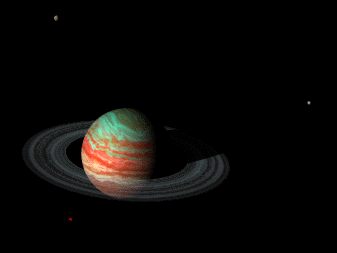
The outer gas giants of our solar system show evidence of internal heat sources, as the observed energy fluxes are above that absorbed from the Sun. What is the expected mean temperature of Los, and thus the expected surface flux (in W/m^2) absorbed in sunlight from Blake and re-emitted in the infrared? Calculate the actual emitted flux using its true mean temperature of 62.2 K.
From a vantage of 2.5 million km, Los has an apparent angular diameter of 3° 32' 52". What is the radius of Los? Using its temperature and radius, calculate the actual and equilibrium energy fluxes (in W) from Los, and take the difference to find the internal power (in W).
The reddish inner satellite Ocalythron has an orbital period of 35 hours 44 min at a radius of 402500 km. What is the mass of Los?
The internal heat of a gas giant could be derived from its gravitational potential energy, by having it contract over time. The total gravitational potential of a planet is approximately given by
which can be differentiated with respect to the radius R to give the emitted luminosity (J/s)
and thus the required contraction rate dR/dt. Compute the total gravitational energy U, the required contraction rate dR/dt (in m/year), and estimate how long Los could produce this power.
Enitharmon is the outermost known gas giant in the Blake system. The Nabonadius flyby was the only mission to this planet, and was able to image the system and deploy an atmospheric probe on its way through.
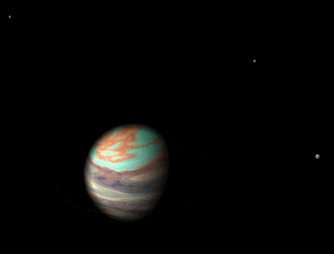
Montage of HRI images from the Nabonadius spacecraft.
From a distance of 1.35 million km, Enitharmon was found to have an angular diameter of 4° 32' 48". What is the radius of Enitharmon?
The inner satellite, Rintrah, was found to have an orbital period of approximately 19 hours 2 min at a distance of 188,000 km. What is the mass and mean density of Enitharmon?
At Rintrah's distance from Enitharmon, tidal effects are substantial. At how many planetary radii does Rintrah orbit? How close is this to the Roche limit? What do you expect Rintrah's rotational period to be, and why?
The radius of Rintrah is found from the images to be 540 km. Estimate the tidal force over Rintrah's radius due to Enitharmon.
The composition of Rintrah might either be entirely rocky (3000 kg/m^3) like Jupiter's satellites or icy (1500 kg/m^3) like the outer planet satellites in our solar system. For these two scenarios, estimate the mass of Rintrah, and thus the surface gravity of the moon. Compare this to the tidal force calculated above in the two cases. Speculate on what Rintrah might be like in the two cases.
The MAX mission to Orc found an icebound terrestrial planet in the outer reaches of the Blake system. The imaging spectrograph shows evidence of an icy surface of frozen nitrogen (N2), methane (CH4), and carbon monoxide (CO), as well as some silicate rock material.
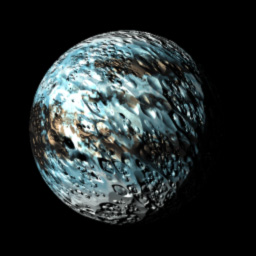
Orc as imaged by the planetary camera of the MAX mission.
The spectrophotometer on board ISUFORC finds an albedo of 0.48 for Orc. Orc is determined to have an eccentric orbit with e=0.2 from ground-based data taken the past decade, and is currently near perihelion. What is the expected mean temperature of Orc at perihelion and aphelion?
In addition to an icy crust, there appears to be an extremely thin atmosphere of nitrogen and methane vapor. Discuss possible origins for Orc's thin atmosphere.
